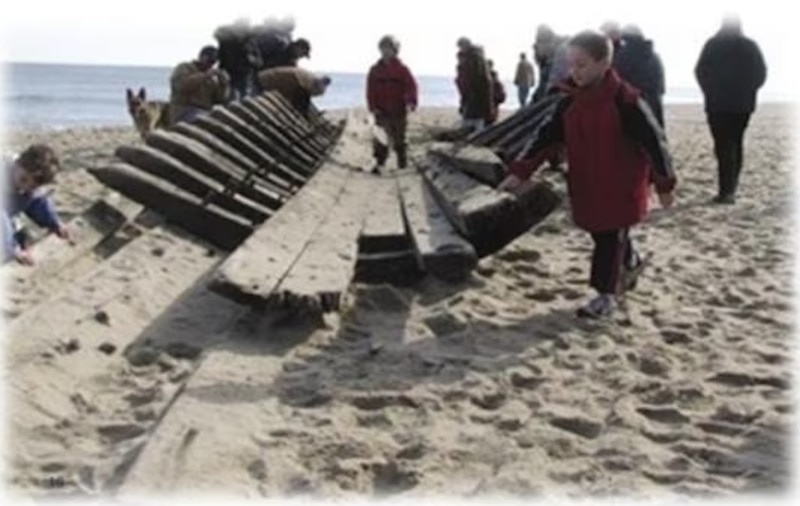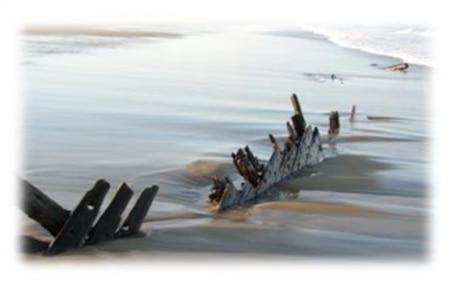Shipwrecks are fascinating windows into maritime days of yore. A wreck and its remains can provide clues to the type and construction of vessels that were operating off the coast, offer a glimpse of seafaring history, and leave people wondering about the fate of the ship and its crew. However, these resources are also vulnerable—their resting places can inadvertently be disturbed, artifacts can be plundered by souvenir collectors and treasure seekers, or the resources can be mistakenly destroyed or lost through neglect. To ensure that historical and archaeological properties are not lost, the Massachusetts Board of Underwater Archaeological Resources (BUAR), administratively supported by the Massachusetts Office of Coastal Zone Management (CZM), helps to discover, report, preserve, and protect the Commonwealth's underwater archaeology and cultural heritage. This CZ-Tip provides information about the role of BUAR and what you can do to help in the quest to discover and preserve maritime artifacts and archaeological findings.
The Regulatory Lowdown on Underwater Archeology - Under the Massachusetts Underwater Archeological Resources Regulations—312 CMR 2.00 (PDF, 188 KB), BUAR is the regulatory authority responsible for protecting underwater archaeological resources within both coastal and inland waters of the state. Part of BUAR's effort focuses on encouraging the discovery and reporting, as well as the preservation and protection, of archaeological sites and objects. The regulations provide specific procedures and requirements (such as through permits and exemptions) for sport divers, archaeologists, historians, and others when discovering, investigating, or recovering these resources. Archaeological resources are generally defined as artifacts, shipwrecks, submerged Native American sites, wharves, aircraft, and other findings that have remained unclaimed for over 100 years or are judged by the Board to be of historic value.
Shipwrecks at the Shore
Given that many archaeological discoveries are made by casual observers on a beach, BUAR developed the Shoreline Heritage Identification Partnerships Strategy (SHIPS) to engage and train the public in the discovery phase of archaeology. According to SHIPS reporting and recording guidelines, when you stumble upon what looks to be a maritime treasure on the beach, follow these steps:
- Report the findings. It is important to report possible artifacts to BUAR as soon as possible since they can quickly be washed back offshore, covered with sediment, or deteriorated by exposure to air and sun. When reporting your find, you will be asked for a brief description of the object, its location, and your contact information so that you can be kept informed. The SHIPS Reporting Form (PDF, 241 KB) is a convenient way to record and report your find.
- Do not remove the item from its location. According to the BUAR Regulations (PDF, 188 KB), no person may remove, displace, damage, or destroy any underwater archaeological resource except in conformity with permits issued by the Board. Ownership of these sites and artifacts that are located on public lands (both dry and underwater) is vested in the Commonwealth.
- Only move the object if it seems likely to be washed away by the tide. If the object is partially buried, do not attempt to dig it up.
- Take photographs and make notes. In a circumstance when an artifact is washed back to the sea or covered by sands before an archaeologist arrives at the site, your information can be included in the database. And to boot, you will have some keepsakes for your own scrapbook.
- Congratulate yourself on helping to piece together a part of history. Once an object is discovered and reported, BUAR staff place the information in an inventory database, where it will be preserved for future public study and benefit. BUAR staff may follow up with you if they plan to visit the discovery location.
Diving Deeper
For those who venture beyond the shores, shipwrecks are also a recreational divers haven—not just for observing these underwater maritime treasures first hand, but also for witnessing the bounty of fish and other marine creatures that use them as habitat. If you want to dive deeper into maritime and natural history, see these links for additional recreational diving information and permit requirements.
- Shipwreck Sites Open to Divers ("Exempted Sites") - This web page explains the requirements for recreational diving activities, including casual artifact collection, on exempted shipwreck sites (which do not require a permit). It also includes descriptions for most of the 40 exempted sites off the Massachusetts coast.
- Reconnaissance Permits (PDF, 344 KB) - This permit is required for divers inspecting and identifying underwater archaeological resources that will have minimal disturbance to the site.
- Excavation Permits (PDF, 285 KB) - This permit is required to uncover and/or remove underwater archaeological resources through the use of disruptive investigation techniques.
- Special Use Permits (PDF, 145 KB) - This permit is granted to qualified archaeologists for environmental review, public planning, and scientific research projects.
- Isolated Find Application Form (PDF, 386 KB) - This is an exemption form to obtain title to an isolated find—an artifact that has been displaced from its original location. The collecting of Isolated Finds is not allowed from archaeological sites or within Underwater Archaeological Preserves (areas established to recognize and protect resources of substantial archaeological and historical value).
Additional Links to Underwater Archaeological Resources
- A Tale of Two Shipwrecks (PDF, 690 KB) - From Sea History magazine (Autumn 2008), this article explores the mystery of a shipwreck found on an outer Cape Cod beach, as well as one found the same year on the Oregon shores.
- The Remains of the H.M.S. Somerset - This article on page 66 of CZM's 2008 Coastlines (PDF, 9 MB) magazine tells the story of the role and fate of this British sailing ship during the Revolutionary War and includes details on where its remains can be found today.
- Precious Cargo: Shipwrecks as Habitat - This article on page 42 of the 2004-2005 Coastlines (PDF, 38 MB) provides insight on how shipwrecks can eventually develop into colorful homes for a variety of fish, mollusk, and plant species.
- Massachusetts Historical Commission - Chaired by the Secretary of the Commonwealth, this 17-member Commission is dedicated to identification, evaluation, and protection of important historical and archaeological assets of Massachusetts.
- Massachusetts Historical Society - This independent research library founded in 1791 offers collections, exhibitions, public lectures, tours, seminars, teacher workshops, and a research library providing valuable resources on American history, life, and culture.
- History & Culture at Cape Cod National Seashore - This website of the National Park Service offers information about archeology and maritime history of the outer Cape, including shipwrecks—such as the wreck of the H.M.S. Somerset.
- Custom House Maritime Museum - Managed by the Newburyport Maritime Society, this museum includes model ships, shipwreck and salvage items, artifacts from far-off voyages, and models of Coast Guard Ships.
- Museum of Underwater Archaeology - The site is designed to help underwater archaeologists and maritime historians present their research online to the public, including reports and photographs of current projects in the field. Exhibit topics include colonial and U.S. Civil War shipwrecks.
- CZ-Tip - Delve into the Mysteries of Maritime Massachusetts - This CZM tip offers intriguing stories on some strange and spooky sea stories that took place on and off the coast of Massachusetts, including details on the shipwrecks of the Whydah and the Jennie M. Carter.
- CZ-Tip - Coastal Activities for Kids - Also by CZM, this tip offers ideas on places for families to explore and learn about the coastal environment, and includes details on museums, education centers, and parks devoted to history, maritime culture, and heritage.
Photographs: Provided by Victor Mastone, BUAR

